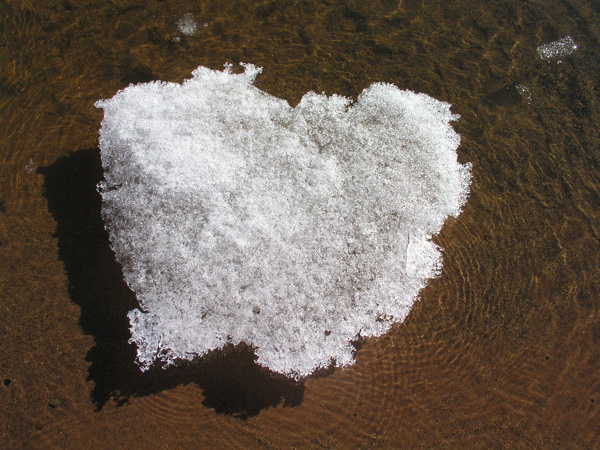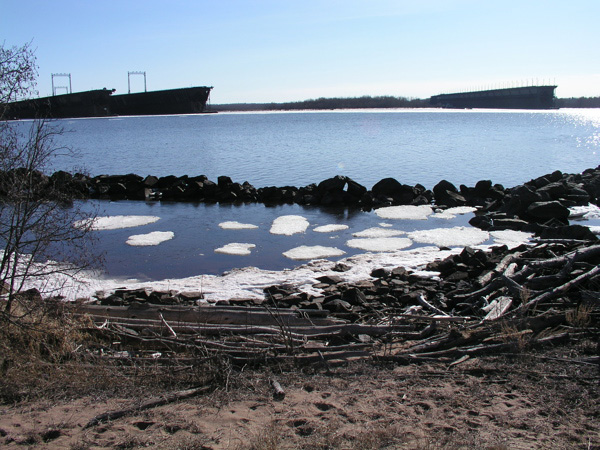The Column: Thaw
Suz Szucs finds a context to think about time, change, photography, and loss, in the disappearance of winter and in the work of photographers









Walking the shoreline of Minnesota Point on a thaw day, last month, I had the notion that if I stood still long enough, I could watch the ice melt. It’s a duration thing – I needed to slow myself down to a rhythm with a different sensibility than human.
Although we are natural creatures, we seem to have lost our sense of the geological continuum. We don’t have time to watch the water smooth out the rocks, trees grow to their full height or ice melt on a warm spring day.
But I wasn’t being particularly philosophical looking at the ice; rather, I had melting on my mind. Before I had reached the Point I had heard via Minnesota Public Radio the Governor of Montana discussing Glacier National Park. He said that the ice was melting so rapidly, that in 25 years there would be no more glaciers in the park. I find that alarming. Glacial: “extremely slow, like the movement of a glacier.” They aren’t supposed to melt practically overnight. Something’s up, and I wondered, feeling uncharacteristic warmth so early in the season, what we, in our rush and hurry, have to do with it.
Photography is about stopped time. It is about capturing in the space of the time it takes for an exposure to be made what is in front of the camera. Given a long enough exposure, we can actually record the time essence of a subject – moments built upon moments before our lens. It is something that we can never witness with unaided eyes because the way we visualize the world is never fixed. Our eyes collect and gather information and relay it to the brain where it is processed into a three-dimensional world. Photography stops that world, providing an objective account of what was there (we add subjectivity, not the camera). Roland Barthes called photography a “little death” because what a photograph collects is always in the past – it will never again exist in precisely the same way.
American photography gained a foothold through the landscape. During the 1870s, photographers, including Alexander Gardner and Timothy O’Sullivan (who both had photographed the Civil War under the auspices of Matthew Brady) accompanied a group of artists out west, their role being to document the new lands as part of the United States Geological Survey. The resulting photographs overwhelmed a curious public in a way that paintings, subject to the artist’s interpretive methods, could not. They caused such a stir, that Congress was moved to create the nation’s first National Park, Yellowstone.
The relationship of the landscape to photography has been consistent ever since, with our most well-known photographer, Ansel Adams, devoting his life to preserving the wilderness. Adams chose to photograph nature as he saw it, larger than life, grand and majestic. His details were in the science of photography, while his images presented a broad vision. Through his work with the Sierra Club and his commitment to conservation (Adams worked politically with the club for many years, acting on their board for 37 years and of course, we all remember the calendars…), Adams inextricably linked his commitment to the environment with his personal vision. For Adams, the personal was very political well before Feminism took up that chant. Adams was also keenly aware of the landscape photographers who had worked before him. One can put his images of Yosemite National Park’s Half Dome next to those made by Eadweard Muybridge and Carleton Watkins half a century before and witness not only stylistic differences, but also changes in the environment.
In the 1970’s western photographer Mark Klett headed the Rephotographic Project, with the intention to re-photograph as precisely as possible images made as part of the US Geological Survey a century before. What emerged is not only a survey of physical, but also cultural changes upon the landscape. Klett and company have created a “Third Look” at these same subjects, returning to photograph them again after 20 years rather than 100. In so doing, they are investigating the rapidity of change upon the landscape – we have speeded it up, building upon foundations that remained virtually unchanged for millennia.
With this in mind, I asked Twin Cities-based photographer Stuart Klipper what kind of changes he had witnessed in the extreme landscapes he has visited. Klipper has been to the ends of the Earth, both the northern and southern poles, over the course of a couple of decades. I have to admit I was surprised when he said he hadn’t seen much change and especially not in Antarctica, because I was expecting tales of iceberg depletion and pollution. He followed that comment up, however, with an expectation that on his next trip to northern regions, he will see quite a bit of change, especially in Greenland, where reports of glaciers melting has been hitting the news. Like Klett, Klipper sees that the last 20 years have been particularly transformative on the environment.
“It’s hard to see change as an image maker,” says Klipper, summarizing my thoughts on the ice melting. Having visited and photographed in Lapland in the late 1980’s, post-Chernobyl – the nuclear accident which, if you haven’t been paying attention to the scant media coverage it received, just “celebrated” its 20th anniversary – he has seen first-hand how catastrophic change can affect not just the land but a people – in this case, Laplanders who rely deeply upon their immediate environment. “Things are not what they seem,” he writes about his experience, and the remark can be attributed to so much of our general problems in dealing with the environment. “All has been suffused with high becquerel counts. The stuff is there, unseen and still ticking out its distressing emissions. The calamity is ensured.” Visible change happens slowly, but the landscape is damaged immediately, invisibly, irrevocably.
What I find frightening is that we are seeing visible change happen much more rapidly these days, and if that is so, then the invisible transformations must be exponentially more dramatic. Indeed, Klipper is working on ways to get back to the Arctic to record some of these transformations. The information that filters into me, suggests that those regions that see most immediate change are those that are closest to human activity, which makes Klipper’s revelation that he hasn’t seen a whole lot of change during his trips to Antarctica make sense.
An ongoing project for Klipper is photographing in each of the 50 states, looking for the “characteristics of American regions.” The biggest environmental changes he seems to have witnessed has been related to human sprawl, clearcutting, drought. I have watched a mountain being clearcut – it’s unforgettable. Trees that have taken decades to form mowed off a mountain in hours. From a distance you can see the machines move across the landscape like they are shaving a beard.
Klipper talks about the need for “counterpoint” in his photographic work. He’s been to the most uninhabited place on the Earth and as a counterpoint, that with the densest concentration of life, the rain forest, as well as everywhere in between. Although he doesn’t set out to send environmental messages with his work, by virtue of his persistence it is there – the unrelenting search for balance.
Nature is forever attempting to create balance out of this bubbling caldron of life. She will adjust to whatever we throw at her, regardless of our well-being. That presents something to really think about. For all those skeptics who insist that global warming is media overblow, consider this: if we can do something through our actions to make our world more habitable, sustainable, beautiful, should we? Nature will take its course in great part based on our decisions and actions.
The ice has all melted on Lake Superior. It took a really long time for a giant pile of snow plowed up in the parking lot of the DECC to melt. I walked by it every day for weeks, long after the lake ice had succumbed to the sun. It was easily 20 feet tall and covered with black dirt and soot from the roadways, so much that it had ceased to look like snow. The soot protected it from the sun, kept it cold and solid long past its natural state.